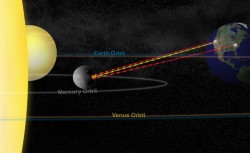Wouldn’t it be easier to see what’s outside the solar system if we just send out probes straight up?
Dammit, science people! Why are you always firing probes “outwards”? Then they have to go past all this stuff, like planets and asteroids and crap to escape the solar system. Don’t you realize that if we want to see what’s outside the solar system we just need to shoot them straight up?
Then we don’t have to go past all that junk, and we can finally see what’s between us and the next star system over! Is it thick goo? Is it thin goo? Is it the aether?!
What the heck is wrong with you! It’s so easy. Just go up! Why are we always going out?
Whenever we talk Solar System, we’re always using flat objects for reference. Plates, flying disks, pancakes and pizzas, as it’s arranged in a flat disk known as the plane of the ecliptic.
Formed from a blob of hydrogen gas and dust in the solar nebula. Gravity pulled everything together, and the conservation of angular momentum set the whole thing spinning, faster and faster. The spinning pulled the whole Solar System into the disk we see today, with our star at the center and the planets embedded in the surrounding disk. As a result, the Sun, Moon, planets and their moons all move through a relatively small region in the sky.
This definitely makes things easier to send spacecraft from world to world. NASA’s Voyager 2 was able to visit Jupiter, Saturn, Uranus and Neptune because they were all lined up like dominoes.
When Willie Sutton was asked why he robbed banks, he answered, “that’s where the money is,” and we explore along the plane of the ecliptic because that’s where the science is. Everything in our Solar System is arranged along this flat area, so it makes sense to look along this region.
But wait! As you know, the Solar System isn’t actually flat. Some objects rise a little above or below the plane of the ecliptic. This is known as a planet’s orbital inclination.

Of all the planets, Mercury has the greatest with 7-percent. It’s even crazier for the the dwarf planets, Pluto is 17-percent off the plane of the ecliptic, and Eris is 44-percent.
One of the reasons Eris went undiscovered for so long is because it orbits so far outside the planet of the ecliptic. It wasn’t until Mike Brown and his team from Caltech looked far enough outside the usual hiding spaces that they found these additional dwarf planets.
There really isn’t much outside the flat plane of the ecliptic, it’s also much more difficult to get spacecraft to travel above or below. When spacecraft launch, they already have tremendous velocity just from the rotation of the Earth and the speed of the Earth orbiting the Sun.
I realize this is just more “outwardist” propaganda for you. So why no “up”? If you did want to go that way, you need a powerful rocket capable of creating velocity in this direction, or that direction.
If you wanted to escape the Earth’s gravity and explore the Solar System in the regular old way, you’d need to add about 10 km/s in velocity to your spacecraft. But for straight up, you’d need about 30 km/s, meaning more fuel, and compromises to your payload.
It still sounds like I’m making excuses. Here’s the deal, you might be amazed to learn that spacecraft actually have been sent “up”.

The European Space Agency’s Ulysses spacecraft, launched in 1990 had the goal of looking down on the Sun from above. It wasn’t possible to do this just with a rocket, but engineers were able to use a gravitational assist from Jupiter to kick Ulysses into an orbital inclination of 80-degrees, and for the first time, we were able to see the Sun from above and below.
A new European mission is in the works called the Solar Orbiter, and it’ll get into an orbital inclination of 90-degrees to be able to see the Sun’s poles directly for the first time. If all goes well, it’ll launch in 2018.
So, why don’t we go up? Actually, we do. We’re going “up” again very soon. It’s good to go up. It’s always good to get outside of our regular stomping grounds and see our Solar System from new angles and perspectives.
If you could send a probe anywhere in our Solar System, where would you choose?


“Of all the planets, Mercury has the greatest with 7-percent. It’s even crazier for the the dwarf planets, Pluto is 17-percent off the plane of the ecliptic, and Eris is 44-percent.”
Dwarf planets are planets too. Of all the planets, Eris and Sedna, not Mercury, have the most eccentric. There is no reason to report a controversial decision by four percent of the IAU as truth when it is just one view in an ongoing debate.
Eris was discovered by three people, the other two being Chad Trujillo and David Rabinowitz. Significantly, Rabinowitz signed Alan Stern’s petition of hundreds of astronomers rejecting the IAU planet definition and claim that dwarf planets are not planets.
Many exoplanet systems have multiple planets all orbiting in different planes. Some of these planets are bigger and more massive than Jupiter. Clearly, having an eccentric orbit does not preclude an object from being a planet.
I always look for your comments. Thanks for another very good one.
well, simple fact, I don’t think anything can get past a low earth orbit….all the rocket launches I have watched arc around and head to the sea…there is no “down range” We are being lied to every day, on a grand scale
woken – Without geostationary satellites (which are in a high orbit), GPS, satellite internet/cable, and lots of other things which are trivially easy to prove exist and work today would not be possible.
gps doesn’t use geostationary orbit satellites, but your point is valid.
Yea um, NASA’s lasted footage showed objects come straight up and out into space,,,,next.
isn’t another reason to fly “out” rather than up because probes pick up speed when they fly by planets?
Yep, the grav. boost is important.
Perhaps from 90 deg. we will be able to see the Sun’s color correctly, for once.
I would like to study the sun’s heliosphere boundary layer at the poles. How much it moves. If it has a charge. How much pressure is on it from the outside. Would be nice just to circle around the sun at this point and map out any ‘flow’ that might occur.